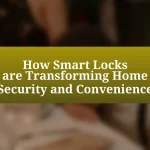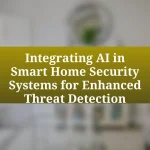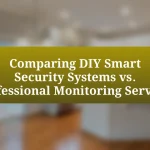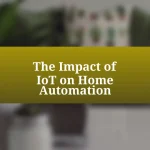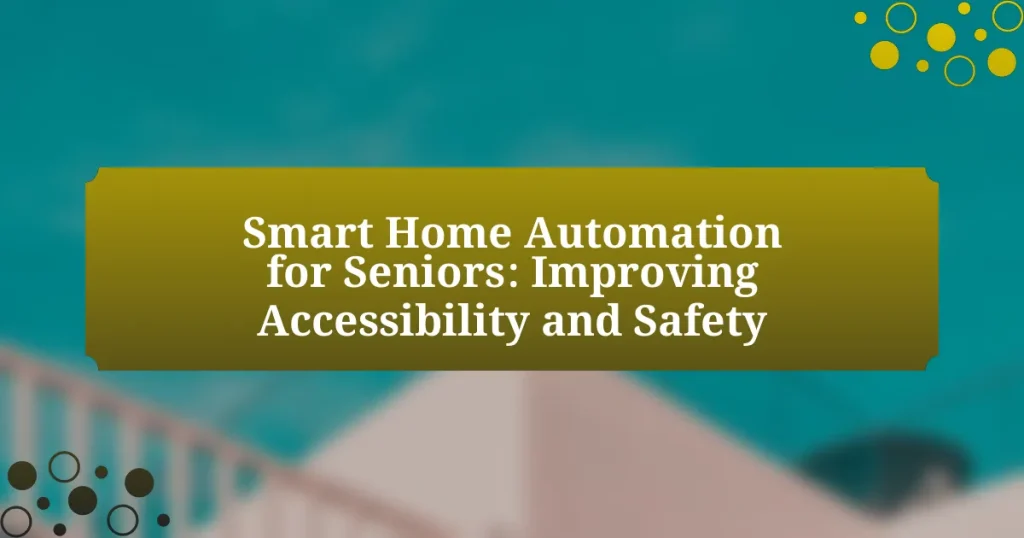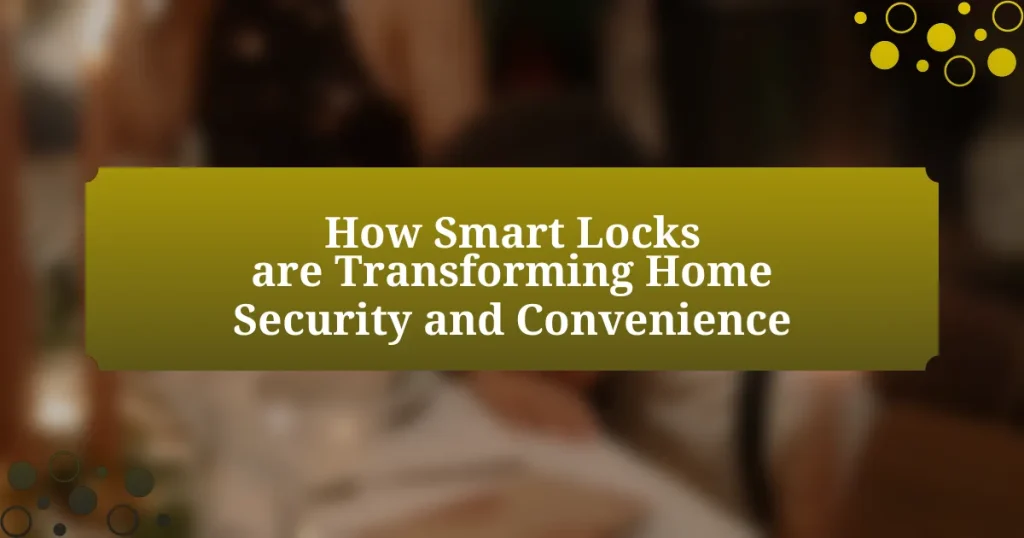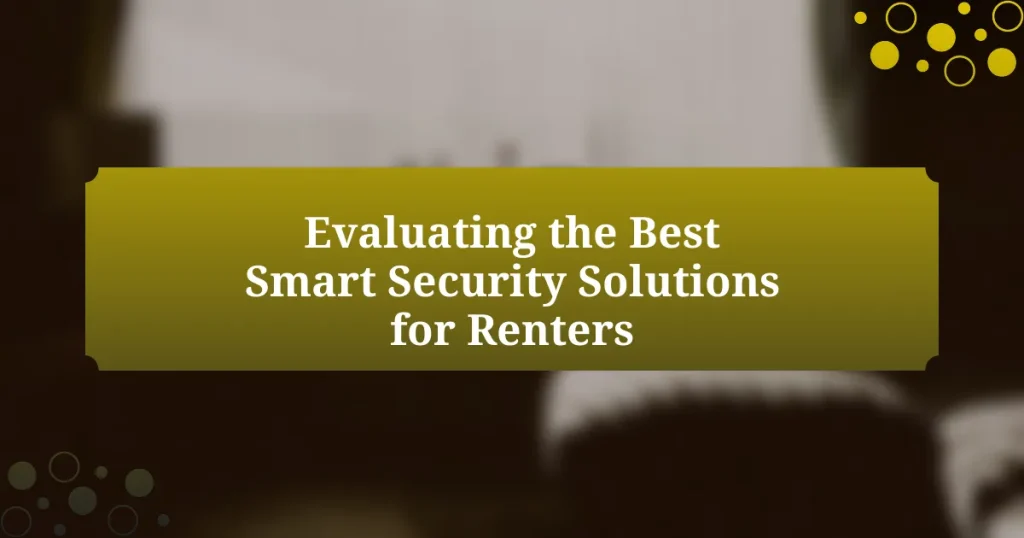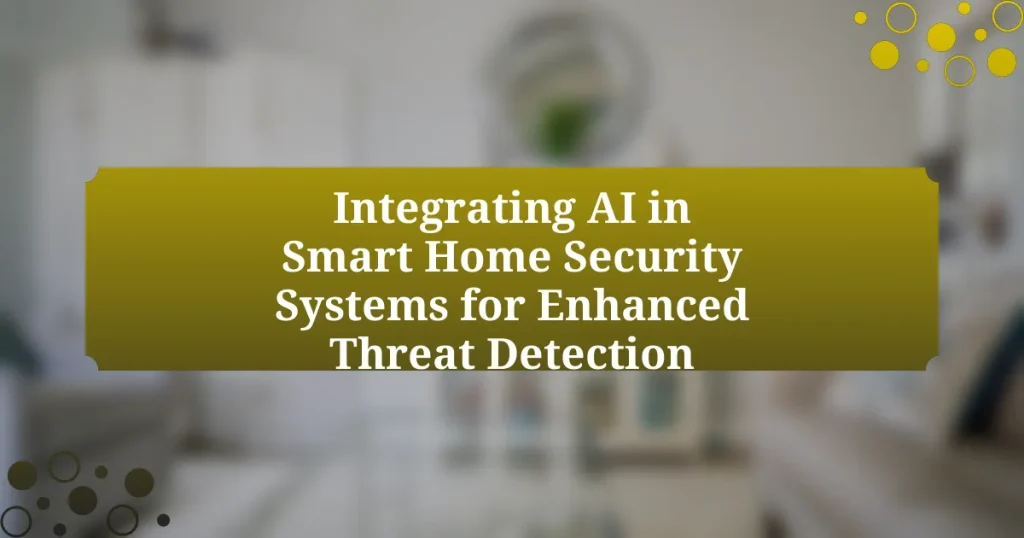Smart home automation for seniors involves the integration of technology to create safer and more accessible living environments for elderly individuals. This article explores how smart devices, such as voice-activated assistants, automated lighting, and health monitoring systems, enhance seniors’ independence and safety, addressing their unique needs. Key benefits include improved daily living, increased security, and the ability to age in place, while also discussing the challenges seniors face in adopting these technologies. Additionally, the article highlights essential design considerations for user-friendly devices and offers practical tips for selecting and maintaining smart home systems tailored to seniors’ requirements.
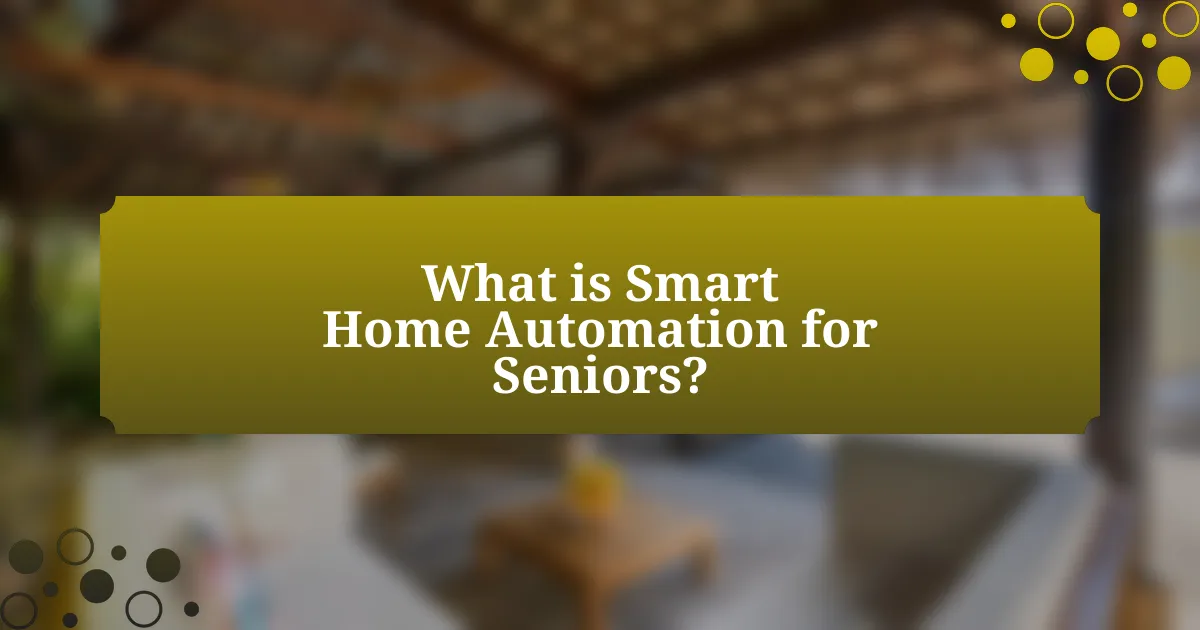
What is Smart Home Automation for Seniors?
Smart home automation for seniors refers to the use of technology to enhance the living environment of elderly individuals, making it more accessible and safer. This system typically includes devices such as smart lighting, automated door locks, and voice-activated assistants, which can help seniors manage daily tasks with greater ease. Research indicates that 90% of seniors prefer to age in place, and smart home technologies can significantly support this preference by reducing the risk of accidents and enabling remote monitoring by caregivers.
How does smart home automation enhance accessibility for seniors?
Smart home automation enhances accessibility for seniors by providing them with user-friendly technology that simplifies daily tasks and increases independence. Features such as voice-activated controls, automated lighting, and smart appliances allow seniors to manage their environment without physical strain. For instance, a study by the AARP found that 71% of older adults are interested in smart home technology that can help them live independently longer. This technology can also include emergency response systems that alert caregivers or family members in case of a fall or medical emergency, further ensuring safety and accessibility.
What specific technologies are used in smart home automation for seniors?
Smart home automation for seniors utilizes specific technologies such as voice-activated assistants, smart lighting, automated door locks, and health monitoring systems. Voice-activated assistants like Amazon Alexa and Google Assistant enable seniors to control devices hands-free, enhancing accessibility. Smart lighting systems can be programmed to adjust automatically, improving safety by reducing the risk of falls in low-light conditions. Automated door locks provide security and convenience, allowing seniors to manage access without physical keys. Health monitoring systems, including wearable devices and smart home sensors, track vital signs and alert caregivers in case of emergencies, ensuring timely assistance. These technologies collectively improve the quality of life for seniors by promoting independence and safety in their living environments.
How do these technologies improve daily living for seniors?
Smart home automation technologies significantly enhance daily living for seniors by increasing accessibility and safety within their homes. These technologies, such as voice-activated assistants, smart lighting, and automated security systems, allow seniors to control their environment easily, reducing the need for physical exertion and minimizing the risk of accidents. For instance, a study by the AARP found that 83% of older adults prefer to age in place, and smart home devices facilitate this by enabling remote monitoring and management of home systems. Additionally, features like fall detection sensors and emergency response systems provide immediate assistance, further ensuring the safety and well-being of seniors in their living spaces.
Why is safety a critical concern for seniors in smart home environments?
Safety is a critical concern for seniors in smart home environments due to their increased vulnerability to accidents and health emergencies. Seniors often face mobility challenges, cognitive decline, and health issues that can lead to falls, injuries, or delayed responses in emergencies. According to the Centers for Disease Control and Prevention, falls are the leading cause of injury among older adults, with one in four seniors experiencing a fall each year. Smart home technologies, such as fall detection systems and emergency response features, can significantly enhance safety by providing immediate assistance and monitoring capabilities. These systems are designed to alert caregivers or emergency services when a senior is in distress, thereby reducing response times and potentially saving lives.
What safety features are commonly integrated into smart home systems for seniors?
Smart home systems for seniors commonly integrate safety features such as fall detection sensors, emergency response systems, smart door locks, and surveillance cameras. Fall detection sensors utilize accelerometers and gyroscopes to identify falls and automatically alert caregivers or emergency services, enhancing immediate response capabilities. Emergency response systems, often linked to wearable devices, allow seniors to summon help with a simple button press. Smart door locks provide secure access control, enabling remote locking and unlocking, which can prevent unauthorized entry while allowing caregivers to assist without physical keys. Surveillance cameras enhance security by allowing seniors and their families to monitor their homes in real-time, providing peace of mind. These features collectively contribute to a safer living environment for seniors, addressing their unique needs and vulnerabilities.
How do these safety features mitigate risks for seniors?
Safety features in smart home automation mitigate risks for seniors by providing real-time monitoring and alerts for potential hazards. For instance, fall detection systems can immediately notify caregivers or emergency services if a senior falls, significantly reducing response time and potentially preventing serious injuries. Additionally, automated lighting can help prevent trips and falls by ensuring that areas are well-lit during the night, which is crucial for seniors who may have impaired vision. Furthermore, smart locks and security systems enhance safety by allowing seniors to control access to their homes remotely, reducing the risk of unauthorized entry. These features collectively create a safer living environment, enabling seniors to maintain independence while minimizing risks associated with aging.
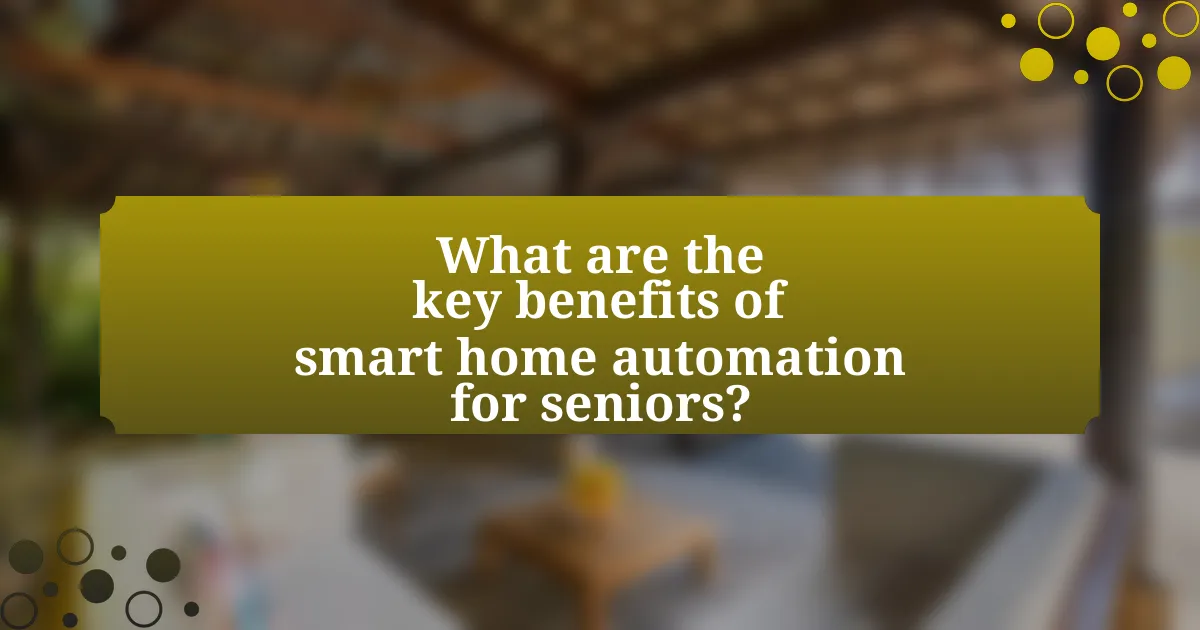
What are the key benefits of smart home automation for seniors?
Smart home automation provides seniors with enhanced safety, convenience, and independence. These systems can include features such as automated lighting, security cameras, and smart locks, which help prevent accidents and provide peace of mind. For instance, automated lighting can reduce the risk of falls by illuminating pathways at night, while security systems can alert caregivers or family members in case of emergencies. Additionally, voice-activated devices allow seniors to control their environment without needing to physically move, promoting greater autonomy. Studies indicate that seniors using smart home technology report higher levels of satisfaction and a greater sense of security in their living environments.
How does smart home automation promote independence among seniors?
Smart home automation promotes independence among seniors by enabling them to manage daily tasks and control their environment with minimal assistance. Features such as voice-activated systems, automated lighting, and smart appliances allow seniors to perform activities like adjusting temperature, turning on lights, and managing security without needing to rely on caregivers. Research indicates that 90% of seniors prefer to age in place, and smart home technologies facilitate this by enhancing safety and reducing the risk of accidents, thereby fostering a sense of autonomy.
What role does remote monitoring play in enhancing senior independence?
Remote monitoring significantly enhances senior independence by allowing caregivers and family members to track health metrics and daily activities from a distance. This technology enables timely interventions in case of emergencies, reducing the need for constant physical supervision. For instance, studies show that remote monitoring systems can decrease hospital readmission rates by up to 25%, as they facilitate proactive health management. By providing seniors with the ability to live alone while ensuring their safety, remote monitoring fosters a sense of autonomy and confidence in their daily lives.
How can automation reduce the need for in-home caregivers?
Automation can significantly reduce the need for in-home caregivers by enabling seniors to manage daily tasks independently. Smart home technologies, such as automated lighting, temperature control, and medication reminders, empower older adults to maintain their routines without assistance. For instance, a study by the AARP found that 77% of older adults prefer to age in place, and automation facilitates this by providing safety features like fall detection and emergency alerts. These technologies not only enhance safety but also promote autonomy, thereby decreasing reliance on caregivers.
What are the emotional and psychological benefits of smart home automation for seniors?
Smart home automation provides significant emotional and psychological benefits for seniors, primarily by enhancing their sense of independence and security. This technology allows seniors to control their environment easily, reducing feelings of helplessness and anxiety associated with aging. For instance, automated lighting can prevent falls during the night, while smart security systems can offer peace of mind by alerting them to potential intrusions. Research indicates that seniors who utilize smart home technologies report higher levels of satisfaction and lower levels of loneliness, as these systems facilitate social interaction through connected devices. Additionally, the ability to manage daily tasks with minimal effort fosters a greater sense of autonomy, which is crucial for maintaining mental well-being in older adults.
How does increased safety contribute to peace of mind for seniors?
Increased safety significantly contributes to peace of mind for seniors by reducing the risk of accidents and enhancing their overall well-being. When seniors feel secure in their environment, they are less anxious about potential dangers, such as falls or intrusions. For instance, smart home technologies like fall detection systems and security cameras can alert caregivers or emergency services promptly, ensuring immediate assistance if needed. Research indicates that seniors who utilize safety-enhancing technologies report higher levels of comfort and independence, which directly correlates with improved mental health outcomes. Thus, the integration of safety measures not only protects seniors physically but also fosters a sense of autonomy and tranquility in their daily lives.
What impact does automation have on social interaction for seniors?
Automation significantly reduces social interaction for seniors by providing them with tools that can perform tasks independently, leading to increased isolation. For instance, smart home devices can manage daily activities such as cooking, cleaning, and medication reminders, which may decrease the need for seniors to engage with family members or caregivers. A study published in the Journal of Gerontology found that seniors who relied heavily on automation reported feeling less connected to their community, as their reliance on technology diminished face-to-face interactions.
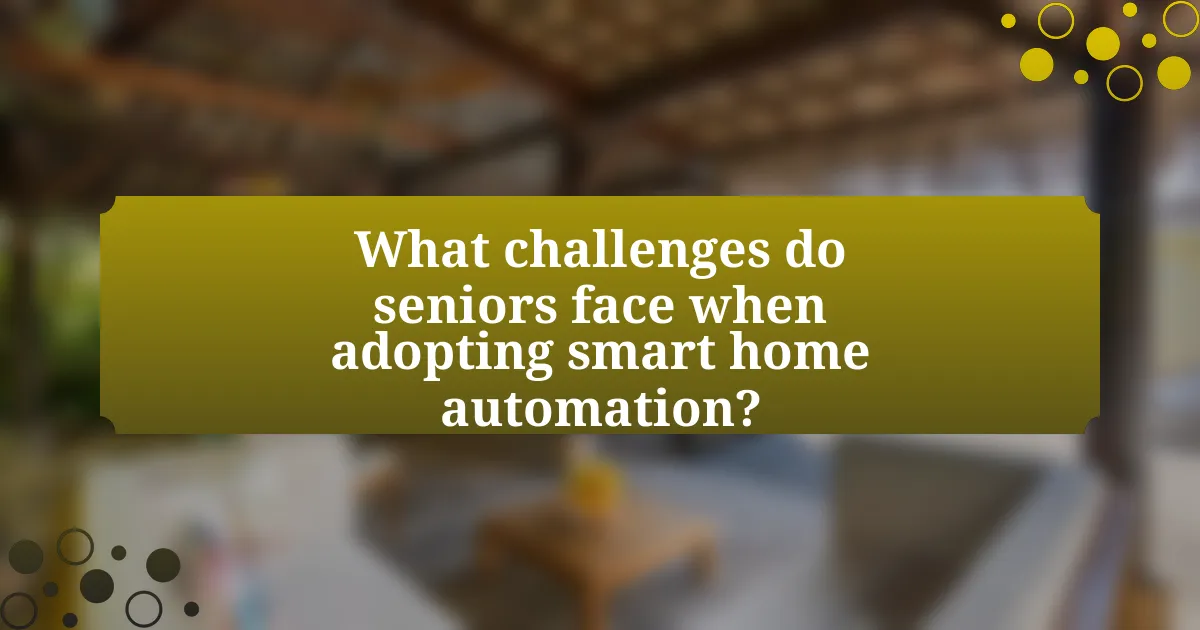
What challenges do seniors face when adopting smart home automation?
Seniors face several challenges when adopting smart home automation, primarily including technological complexity, cost, and physical limitations. The complexity of smart home systems can overwhelm seniors who may not be familiar with modern technology, leading to difficulties in setup and operation. Additionally, the financial burden of purchasing smart devices and ongoing service costs can be prohibitive, especially for those on fixed incomes. Physical limitations, such as reduced mobility or vision impairments, can hinder seniors’ ability to interact with devices effectively. According to a study by the AARP, 83% of older adults expressed concerns about the usability of technology, highlighting the need for more intuitive designs tailored to their needs.
How can technology be made more user-friendly for seniors?
Technology can be made more user-friendly for seniors by simplifying interfaces and enhancing accessibility features. This includes using larger text, high-contrast colors, and intuitive navigation to accommodate visual impairments and cognitive challenges commonly faced by older adults. Research indicates that 70% of seniors prefer devices with straightforward designs and minimal steps to complete tasks, highlighting the importance of user-centered design in technology development. Additionally, incorporating voice-activated controls and personalized assistance can further enhance usability, as studies show that seniors are more comfortable using technology that responds to natural language commands.
What design considerations are essential for senior-friendly smart home devices?
Essential design considerations for senior-friendly smart home devices include simplicity, accessibility, and safety features. Simplicity ensures that interfaces are intuitive, with large buttons and clear icons, making it easier for seniors to navigate technology. Accessibility involves voice control and compatibility with assistive devices, allowing users with mobility or vision impairments to operate devices effortlessly. Safety features, such as emergency alerts and fall detection, provide peace of mind and immediate assistance when needed. Research indicates that user-centered design significantly enhances usability for older adults, as highlighted in studies by the AARP, which emphasize the importance of these considerations in promoting independence and security in smart home environments.
How can training and support be provided to seniors using these technologies?
Training and support for seniors using smart home automation technologies can be provided through personalized instruction, ongoing assistance, and user-friendly resources. Personalized instruction can include one-on-one sessions where trained professionals demonstrate how to use devices, ensuring that seniors feel comfortable and confident. Ongoing assistance can be offered via dedicated helplines or in-home visits, allowing seniors to receive help whenever they encounter difficulties. User-friendly resources, such as simplified manuals and video tutorials, can further enhance understanding and usability. Research indicates that tailored training programs significantly improve technology adoption rates among older adults, as evidenced by a study published in the Journal of Gerontological Nursing, which found that seniors who received personalized training were 60% more likely to use smart technologies effectively.
What are common misconceptions about smart home automation for seniors?
Common misconceptions about smart home automation for seniors include the belief that technology is too complicated for them to use and that it is prohibitively expensive. Many seniors are capable of learning and using smart devices, as studies show that older adults can adapt to technology with proper training and support. Additionally, while some smart home systems can be costly, there are affordable options available that can significantly enhance safety and accessibility, such as smart lights and voice-activated assistants.
Why do some seniors believe smart home technology is too complicated?
Some seniors believe smart home technology is too complicated due to its reliance on advanced interfaces and features that may not be intuitive for them. Many smart devices require a level of technological literacy that older adults may not possess, leading to feelings of frustration and confusion. Research indicates that approximately 40% of seniors express difficulty in using technology, primarily because of unfamiliarity with digital interfaces and the rapid pace of technological change. This gap in understanding can create a perception that smart home systems are overly complex and inaccessible.
How can these misconceptions be addressed to encourage adoption?
Misconceptions about smart home automation for seniors can be addressed through targeted education and demonstration programs. Providing clear, accessible information about the technology’s benefits, such as enhanced safety and improved quality of life, can alleviate fears and misunderstandings. For instance, studies show that 70% of seniors express concerns about technology complexity, yet hands-on workshops that allow seniors to interact with devices can significantly increase comfort levels and willingness to adopt. Additionally, testimonials from peers who have successfully integrated smart home solutions can serve as powerful motivators, reinforcing the idea that these technologies are user-friendly and beneficial.
What practical tips can help seniors effectively use smart home automation?
Seniors can effectively use smart home automation by simplifying device interfaces and utilizing voice-activated technology. Simplified interfaces, such as large buttons and clear labels, enhance usability for seniors who may struggle with complex technology. Voice-activated systems, like Amazon Alexa or Google Assistant, allow seniors to control devices hands-free, reducing the need for physical interaction with gadgets. Additionally, setting up automated routines for daily tasks, such as turning on lights or adjusting thermostats, can help seniors maintain independence while ensuring safety. Research indicates that 80% of seniors feel more secure in their homes with smart technology, highlighting its effectiveness in improving accessibility and safety.
How can seniors choose the right smart home devices for their needs?
Seniors can choose the right smart home devices by assessing their specific needs, preferences, and the usability of the technology. They should prioritize devices that enhance safety, such as smart doorbells with cameras, smart smoke detectors, and automated lighting systems that can prevent falls. Additionally, seniors should consider ease of use; devices with simple interfaces, voice control options, and compatibility with existing technology are ideal. Research indicates that 70% of seniors prefer devices that can be controlled via voice commands, highlighting the importance of user-friendly features. By focusing on these criteria, seniors can effectively select smart home devices that improve their quality of life and ensure their safety at home.
What are best practices for maintaining and troubleshooting smart home systems?
Best practices for maintaining and troubleshooting smart home systems include regular software updates, ensuring strong Wi-Fi connectivity, and conducting routine checks on devices. Regular software updates are crucial as they enhance security and functionality, with many manufacturers releasing updates to fix vulnerabilities. Strong Wi-Fi connectivity is essential because most smart home devices rely on a stable internet connection; using a mesh network can improve coverage. Routine checks on devices, such as verifying that sensors and cameras are functioning correctly, help identify issues before they escalate. Additionally, creating a backup of system settings can facilitate quick recovery in case of failures.

